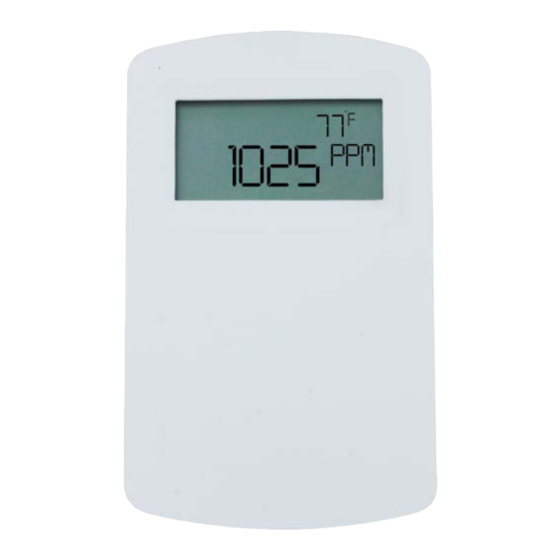Table of Contents
Advertisement
Quick Links
Series CDT and CDTR Wall Mount Carbon Dioxide/
Temperature Transmitter
Specifications - Installation and Operating Instructions
European
Series CDT and CDTR Wall Mount Carbon Dioxide Temperature Transmitters
accurately monitor the CO
concentration and temperature in schools, office buildings,
2
and other indoor environments to help achieve LEED
Series CDTR also measures ambient relative humidity. For increased sensor life,
a single- beam dual-wavelength non-dispersive infrared (NDIR) sensor is used to
automatically correct the measurement in both occupied and unoccupied buildings
against aging effects. The single-beam dual-wavelength sensor technology provides
the highest level of accuracy compared to Automatic Baseline Correction methods,
which can unintentionally shift the calibration based on CO
pressure conditions. In order to achieve a higher level of accuracy, the Series CDT
includes digital barometric pressure adjustment and the ability to field-calibrate the
sensor.
Universal outputs allow users to select the transmitter output to be 4 to 20 mA, 0 to
5 VDC, or 0 to 10 VDC to work with virtually any building management controller. An
optional relay with user adjustable set points can be used to control exhaust fans, open
actuated windows or dampers, or signal a light or horn.
For applications that require visual indication, the Series CDT and CDTR can be
ordered with an integral LCD display, Model A-449 or Model A-449A remote LCD
display that can plug into the mini-connector port on the side of the transmitter. Both
the CDT and CDTR can be configured to display temperature only, CO
and temperature together. The Series CDTR can also display relative humidity or
CO
and relative humidity together. Push buttons are standard on the transmitters for
2
access to the menu structure, but the transmitter can be ordered without the buttons.
To prevent tampering, the action of the buttons can be locked out using an internal dip
switch selection. Menu items that can be accessed include: engineering units, relay
output set points, display configuration, transmitter output scaling, ambient barometric
pressure and field calibration of the transmitter.
Single-beam dual-wavelength sensor advantages:
• Automatically corrects for aging effects in occupied and unoccupied buildings*
◦ Perfect for hospitals and manufacturing plants that are occupied 24 hours per
day
• Measures actual unfiltered light intensity directly
◦ Eliminates error from incorrect assumptions of gas concentration in theoretical
logic assumption methods
* For buildings occupied 24 hours per day, it is recommended that calibration be
verified every 6 to 12 months depending on application.
DWYER INSTRUMENTS, INC.
P.O. BOX 373 • MICHIGAN CITY, INDIANA 46360, U.S.A.
3.65
[92.72]
North American
certification. Additionally, the
®
levels and barometric
2
only, or CO
2
2
1.08
[27.33]
3.56
[90.42]
SPECIFICATIONS
Sensor: Single beam, dual-wavelength NDIR.
Range: CO
: 0 to 2000 or 0 to 5000 ppm (depending on model); Temperature: 32 to
2
122°F (0 to 50°C).
Accuracy: CO
: ±40 ppm ±3% of reading; RH: ±2% (10 to 90% RH) (for units
2
configured with humidity output); Temperature: ±1°C @ 25°C.
Temperature Dependence: ±8 ppm/°C at 1100 ppm.
Non-Linearity: 16 ppm.
Pressure Dependence: 0.13% of reading per mm of Hg.
Response Time: 2 min for 99% step change.
Temperature Limits: 32 to 122°F (0 to 50°C).
Humidity Limits: 10 to 95% RH (non-condensing).
Power Requirements: 16 to 35 VDC or 19 to 28 VAC.
Power Consumption: Average: 2 w; Peak: 3.75 w.
Output: Current: 4 to 20 mA (max. 500 Ω); Voltage: 0 to 5 VDC or 0 to 10 VDC
(min. 500 Ω); Relay: SPST NO rated 2A @ 30 VDC; RTD or thermistor per r-t
curves on page 4 (depending on model).
Weight: 4.4 oz (125 g).
Agency Approvals: CE.
INSTALLATION
Disconnect power supply before installation to prevent electrical
CAUTION
shock and equipment damage.
Make sure all connections are in accordance with the job wiring diagram and in
accordance with national and local electrical codes. Use copper conductors only.
Use electrostatic discharge precautions (e.g., use of wrist straps)
NOTICE
during installation and wiring to prevent equipment damage.
Avoid locations where severe shock or vibration, excessive
NOTICE
moisture or corrosive fumes are present.
NOTICE
Do not exceed ratings of this device, permanent damage not
covered by warranty may result.
Upon powering the transmitter, the firmware version will flash on
NOTICE
the display. A warm up period of 30 minutes is required for the
transmitter to adjust to the current CO
NOTICE
Self calibration feature of the transmitter requires exposure to
normal outdoor equivalent carbon dioxide level once every thirty
days.
LEED
®
is a registered trademark of the U.S. Green Building Council
Phone: 219/879-8000
Fax: 219/872-9057
Bulletin AQ-CDT/CDTR-E/N
[27.96]
4.50
[114.30]
2.80
[71.12]
concentration.
2
www.dwyer-inst.com
e-mail: info@dwyermail.com
1.10
Advertisement
Table of Contents

Summary of Contents for Dwyer Instruments CDT Series
- Page 1 LEED ® is a registered trademark of the U.S. Green Building Council DWYER INSTRUMENTS, INC. Phone: 219/879-8000 www.dwyer-inst.com P.O. BOX 373 • MICHIGAN CITY, INDIANA 46360, U.S.A. Fax: 219/872-9057 e-mail: info@dwyermail.com...
- Page 2 Current / Voltage Outputs On the Series CDT, the transmitter may be wired for current or voltage output for both carbon dioxide and temperature. On the Series CDTR, the transmitter may be wired for current or voltage output for both carbon dioxide and humidity. The transmitter can be powered with either 16 to 35 VDC or 19 to 28 VAC.
- Page 3 Menu Descriptions Relay on set point Humidity low output range (Series CDTR only) Sets the CO concentration which the optional relay is energized. Sets the humidity for the lowest output (4 mA or 0 VDC). Low limit: 0 PPM Low limit: 0.0% Factory setting: 1000 PPM...
- Page 4 302.0 237.00 186.10 55.83 157.33 1573.3 Figure 10: Resistance vs Temperature ©Copyright 2019 Dwyer Instruments, Inc. Printed in U.S.A. 1/19 FR# 443800-30 Rev. 8 DWYER INSTRUMENTS, INC. Phone: 219/879-8000 dwyer-inst.com P.O. BOX 373 • MICHIGAN CITY, INDIANA 46360, U.S.A. Fax: 219/872-9057...















Need help?
Do you have a question about the CDT Series and is the answer not in the manual?
Questions and answers